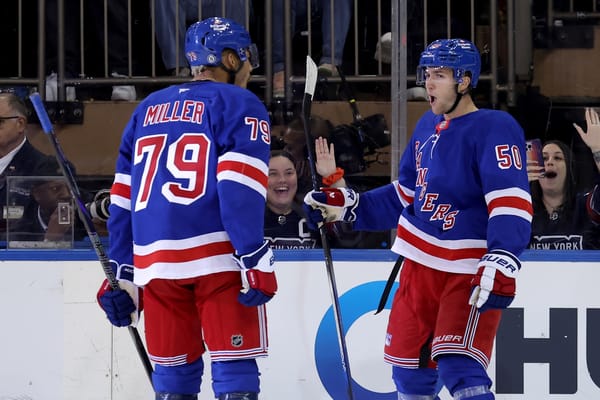Fighting and Hockey’s Concussion Problem
A month ago I wrote a piece about the decline of fighting in New York Rangers hockey. In the closing paragraph I couldn’t resist pointing out that fighting slowly dying out was a good thing for the health and safety of hockey players.
A part of the game that gets harder and harder to defend and justify with each passing year, each new study, and each tragic headline.
It’s all too easy to vilify fighting for hockey’s concussion problems.
Bare-knuckle boxing matches with almost exclusively punches to the head taking place on a sheet of ice over a slab of concrete make for a logical and convenient scapegoat. But most of hockey’s concussions aren’t coming from fights.
Ice Guardians, a documentary about the role of the hockey enforcer eight years in the making, will be released this fall. The documentary allows some of hockey’s toughest skaters, including former Rangers Colton Orr and Joe Kocur, to tell their side of the story. It will also provide some valuable perspective on hockey’s concussion problem.
“The elephant in the room [is] only five percent of concussions are coming from fighting,” Ice Guardians’ producer Adam Scorgie shared on the Marek vs. Wysyshnski podcast. “But if you were a general observer of hockey or just an outside fan, you would think with all the media attention on fighting, ‘Oh man, fighting’s gotta cause 40 to 50, 60 percent.’
“So to find out it’s less than ten percent [it’s] like, ‘Wow, really?’ We should be putting a lot more attention on the elephant in the room which is the speed of the game and the equipment.”
The statistic Scorgie quoted regarding only five percent of concussions being caused by fighting comes from an interview with a doctor that will be featured in the film. Scorgie also shared that concussion doctors were hesitant to be interviewed for Ice Guardians. And given the ongoing raging debate about concussions in professional sports, it’s easy to understand why.
A concussion can be caused by trauma to any part of the body. A concussion is the result of the human brain sliding forcefully through cerebrospinal fluid into the interior of the human skull. Really, almost any significant violence to the human body can cause a concussion.
Ice hockey is a fast and violent sport. As Scorgie suggested on Marek vs. Wyshynski the speed of the game is the underlying cause of the vast majority of ice hockey concussions. Players regularly collide with one another and with the boards at great speeds. And after collisions and falls players make contact with an inch of ice covering a concrete foundation. It’s a great recipe for violent trauma to the human body and, more specifically, the human brain.
Shots are getting harder, players are getting stronger, and the game keeps getting faster. Some argue that modern equipment has only emboldened players and could be making collisions more dangerous. Are bigger, harder shoulder pads causing more injuries than they’re preventing? Is the modern game more dangerous with less clutching and grabbing to slow players down?
This season the NHL is taking their fight against concussions more seriously, or at least they are trying to make it appear that way. The league will have four concussions spotters watching each and every game from a centralized location in either Toronto or New York. There will also be spotters at games to check for symptoms that will have the authority to pull players from the game.
"It's a pretty major revamp from what it was last year," NHL Deputy Commissioner Bill Daly boasted. "We're going to have both those (remote and on-site) spotters, plus you have the clubs' medical staffs. We're just building in reinforcements, really, to make the system work better."
Before the most recent update to the NHL’s “system” teams had dedicated concussion spotters who didn’t have the authority to remove players from a game. The league, which is still facing a concussion lawsuit from former players, is trying demonstrate that it’s taking concussions more seriously. Unfortunately this new protocol won’t prevent concussions from happening. That’s a big problem.
The bottom line is we don’t know how to dramatically reduce concussions in hockey without robbing the game of the things that make it great- and no, I’m not talking about fighting.
We all hope that new helmets, new rules, and new studies will give us fewer motionless players on the ice being attended to by athletic trainers in hauntingly quiet arenas. Fewer promising careers cut short in the blink of an eye. Fewer CTE-related tragedies to endure. But we still expect, and in many ways accept, the reality of concussions in hockey. We know they’re not going anywhere.
Mike Sauer’s NHL career ended with that hit.
Many hockey fans are quick to point to fighting when discussions and debates about concussions in hockey begin. Given all that has happened in the past five years, it’s easy to understand why.
We know that fighting isn’t the main cause of concussions in hockey. But we still need to ask honest questions about its role in the game and the risks it poses to the health of players. Hockey fights are by nature extremely dangerous and that is one reason why many hockey fans find them superfluous and needless in the modern game.
Fighting shouldn’t be the scapegoat in hockey’s concussion debate/discussion. But it will continue to be as long as it remains a part of the game. When we blame fighting for all of hockey’s ills we tend to cast former and current fighters as reckless, lawless individuals who are a detriment to the game. And that’s both irresponsible and inaccurate.
There’s no denying that fighting plays an important role in hockey’s concussion problem. But the answers we need to create a better, safer game go far beyond the fighting debate. We need to remember that.




